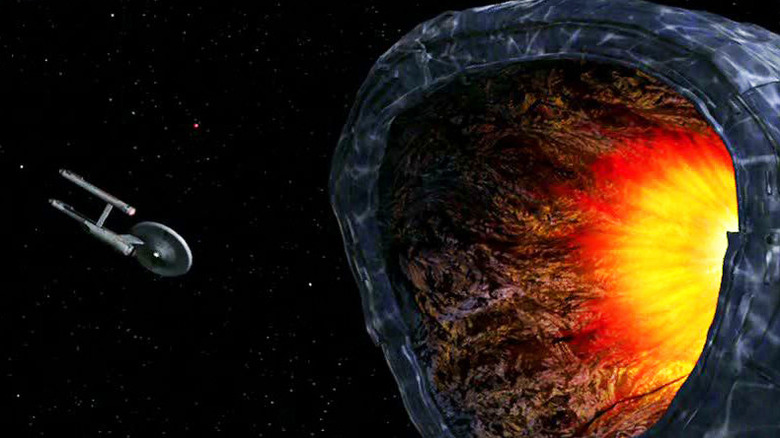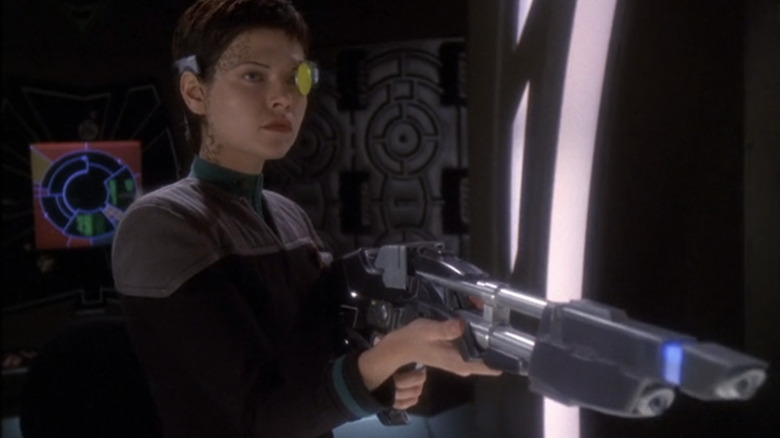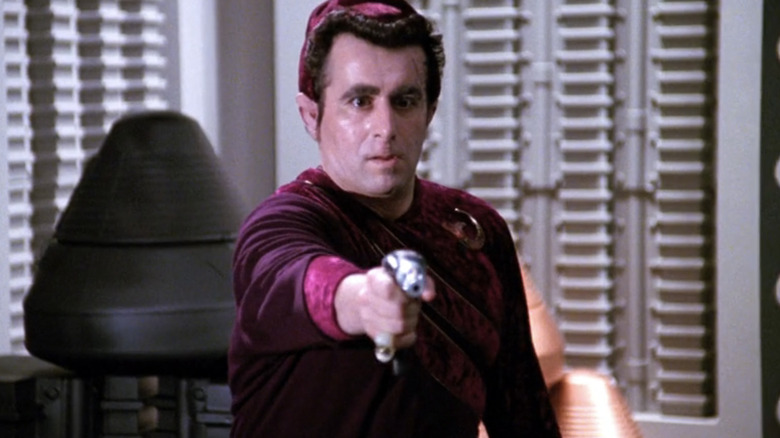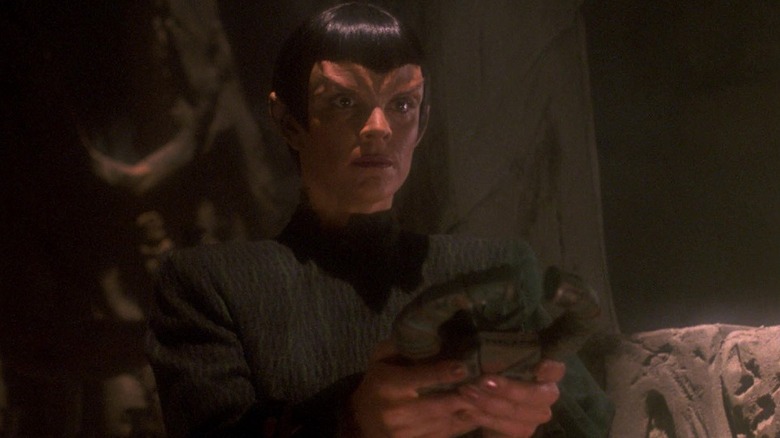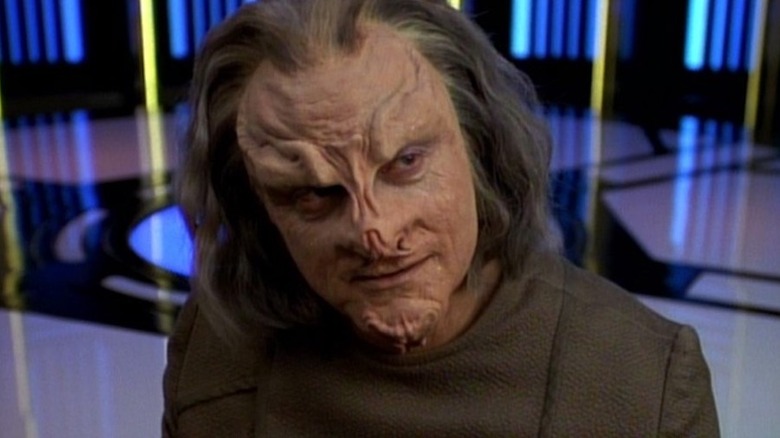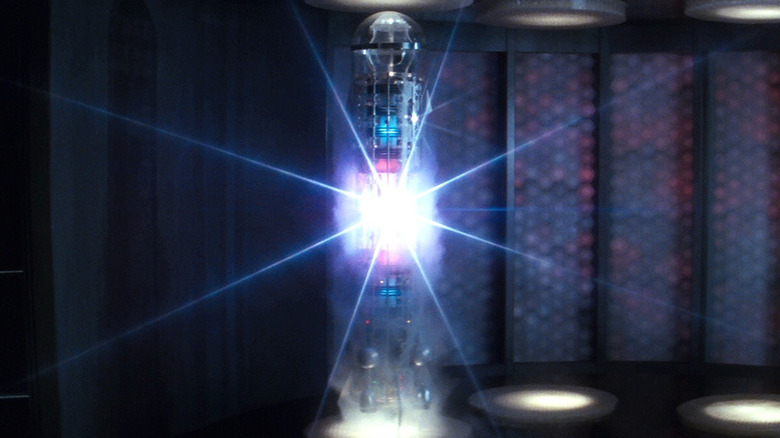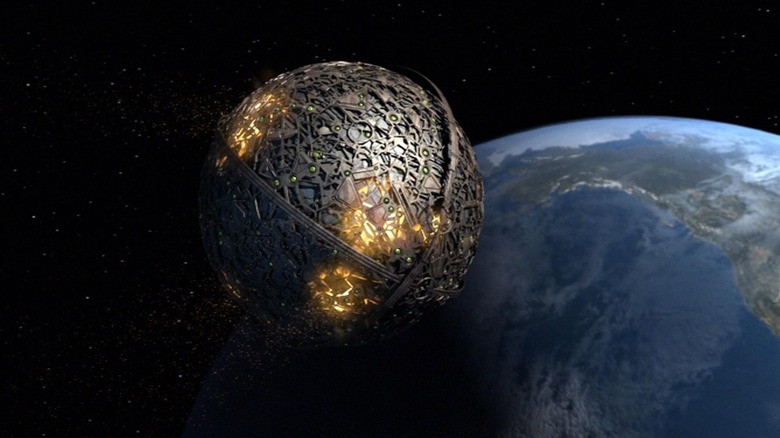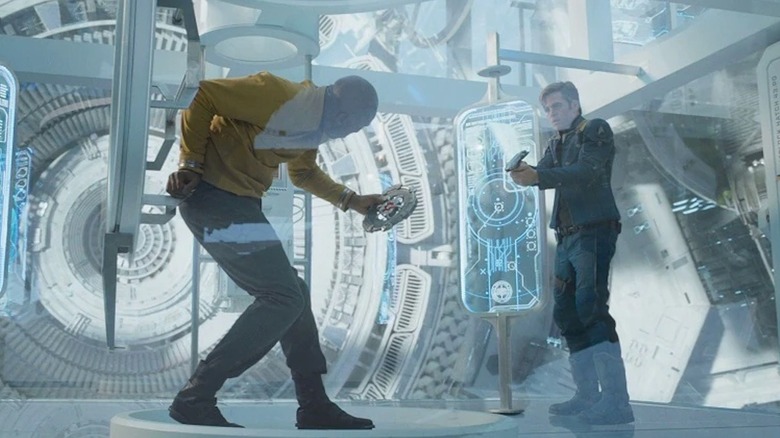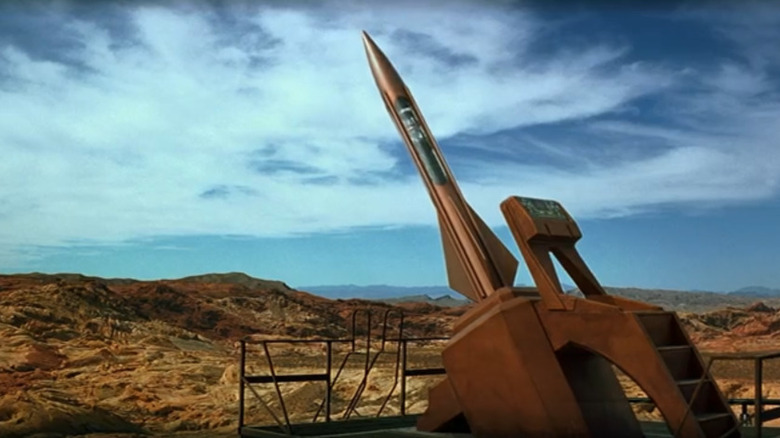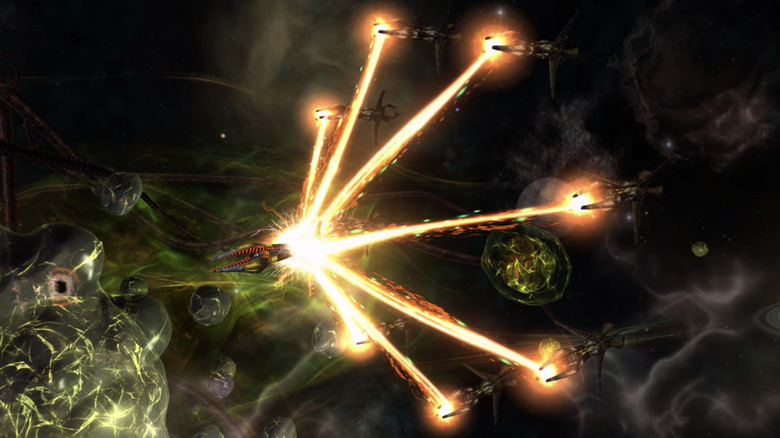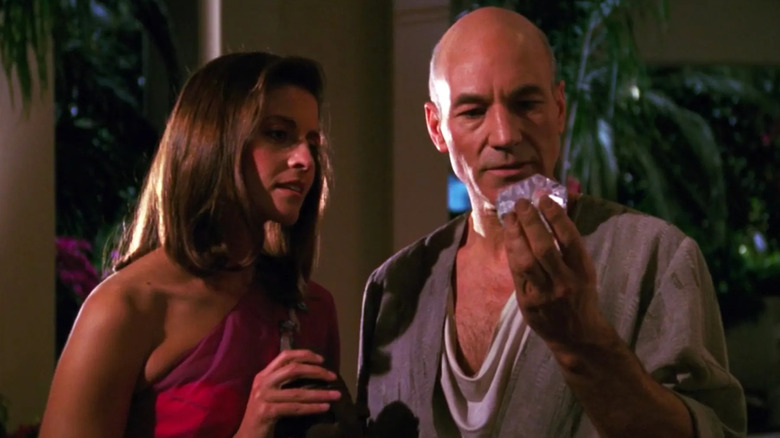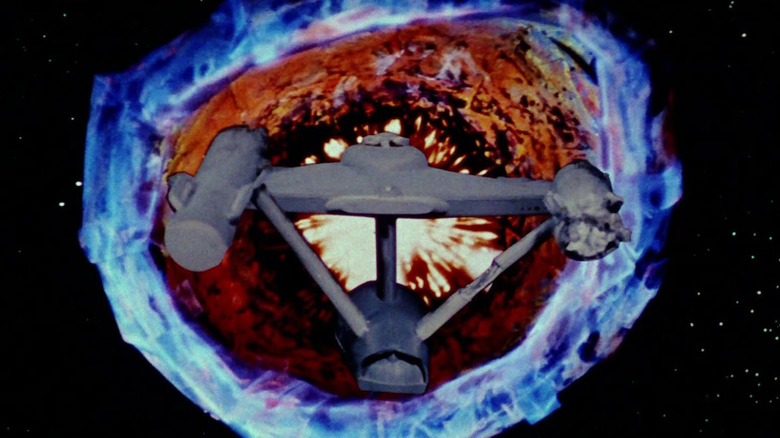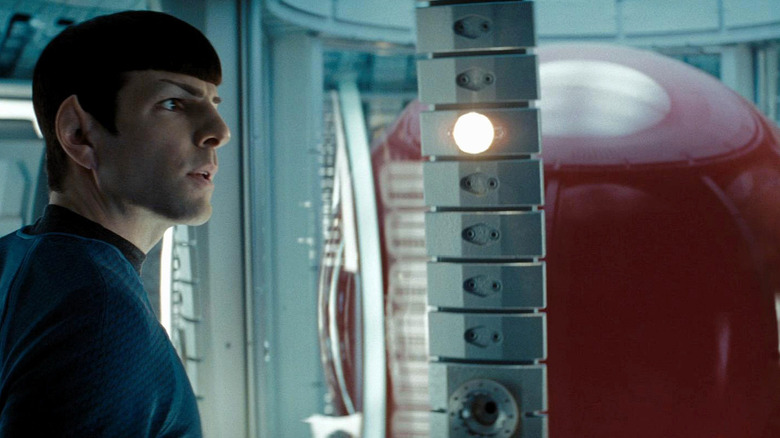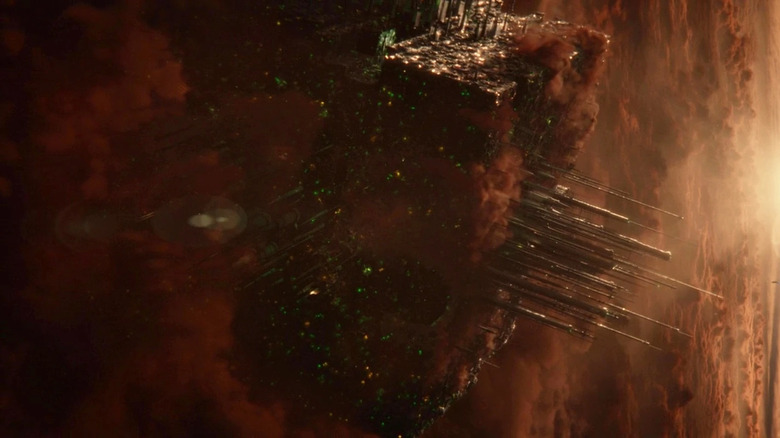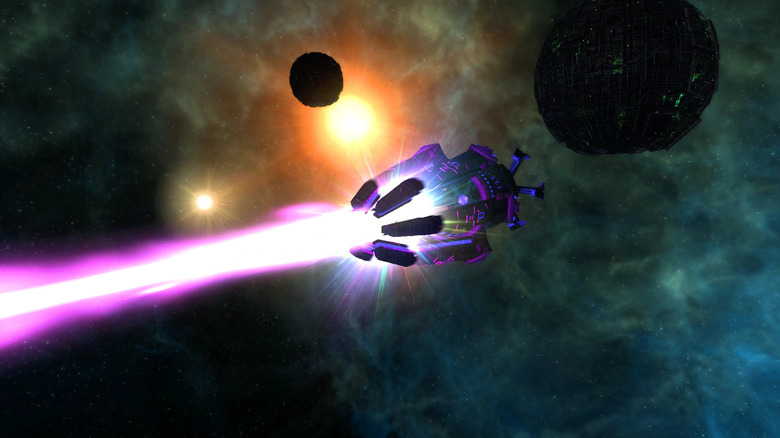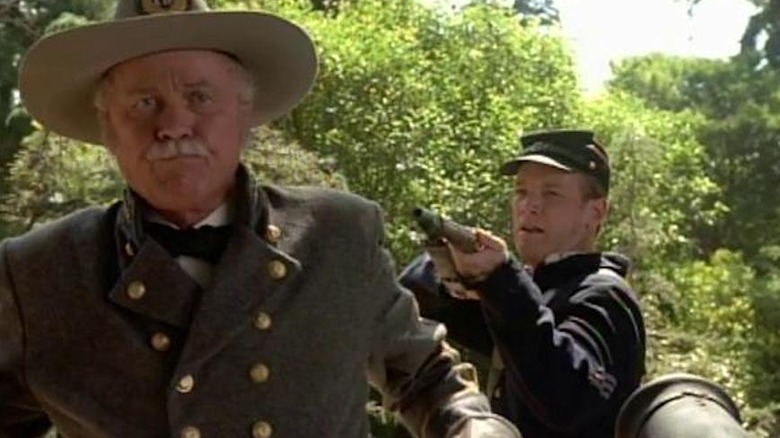The 15 Most Powerful Weapons In Star Trek, Officially Ranked
Since the original series began airing in 1966, "Star Trek" has been known for its advanced technology, many elements of which have since become staples of pop culture like the transporter or warp engines. But while many fans and even the general public love to talk about all of the scientific gadgets that "Star Trek" invented, it's often overlooked just how much tremendous, devastating firepower has come out of a franchise famous for its optimistic view of the future.
While there are many incredibly powerful elements in "Trek" lore — like the infamous Omega Particle — we're talking weapons here, from phasers to photon torpedoes and beyond. Some of them can kill thousands, while others can cause massive destruction on a cosmic scale. Whether they hail from the original 1966 series, "Star Trek: The Next Generation," or even the J.J. Abrams movies, we've found the 15 most powerful weapons in "Star Trek," and we've ranked them here — with the biggest and baddest of all time down below.
15. Chu'lak's TR-116 rifle
The most powerful weapons in the "Star Trek" universe tend to be the ones that can wipe out millions in a single blow, but handheld weapons aren't to be ignored. In that category, we present the TR-116 prototype rifle from the episode "Field of Fire," a Season 7 installment that ranks among the most underrated episodes of "Star Trek: Deep Space Nine."
Developed by Starfleet for situations where energy-dampening fields would inhibit phasers, the TR-116 eschews phasers in favor of a lethal, chemically-propelled projectile. Yet that's not what makes it so powerful. Instead, it's an ingenious modification made by a Vulcan officer named Chu'lak (Marty Rackham): a micro-transporter. This allows the wielder to hit targets through walls, bulkheads, and across vast distances — essentially anywhere in transporter range — and thanks to an exographic targeting scanner, the shooter never needs to leave their home.
Admittedly, the episode never stresses how dangerous the TR-116 is with these modifications. But a rifle that can be fired from the safety of a hidden position, with a transporter that makes the projectile nearly untraceable, earns it a place on our list.
14. Varon-T disruptor
It has an unassuming look, but the Varon-T disruptor might be the most lethal handheld weapon we've seen in any iteration of "Trek." In the "Star Trek: The Next Generation" episode "The Most Toys," it belongs to cosmic collector Kivas Fajo (Saul Rubinek), who uses it to get the android Data (Brent Spiner) to comply with his wishes. According to Data, the Varon-T was, like the TR-116, an experimental prototype. Only five were ever made, and Fajo claims to have four of them — including one that he keeps under his pillow.
Deadly and downright vicious, a shot from a Varon-T can tear living flesh to pieces from the inside out. In fact, its power and cruelty are so unmatched that the Varon-T is banned by the Federation, making the four in Fajo's collection more than just a veritable arsenal of death, but a valuable commodity as well.
13. The Stone of Gol
In the "TNG" episode "Gambit" we are introduced to an ancient artifact from Vulcan mythology called the Stone of Gol. As legend has it, the Stone of Gol can kill with a thought from anyone who holds it, but it is no myth: It's a very real weapon that is re-assembled by Vulcan extremists led by an agent named T'Paal (Robin Curtis). As she reveals to Captain Picard (Patrick Stewart) in the two-part episode's climax, the Stone of Gol is actually a psionic resonator capable of focusing a person's own telepathic energy. With it, a person can quite literally kill with a thought, and ancient Vulcans used the Stone of Gol during a time of great turmoil centuries before.
The problem with the Stone of Gol, and why it doesn't rank higher, is that it has one glaring weakness. Demonstrated by Picard, its power is derived from the violent emotions of its intended victim, so if one can empty their minds and be at peace, the stone has no power at all. This is precisely why the weapon was dismantled ages ago, following the Vulcan Enlightenment, when the teachings of Surak saw Vulcan society abandon all emotion — making the Stone of Gol obsolete.
12. The Metreon Cascade
"Star Trek" leans heavily into social allegory often, and in the "Voyager" episode "Jetrel" we learn the history of Neelix's (Ethan Phillips) homeworld Talaxia and a great war eerily reminiscent of our own Second World War. In this conflict, the Talaxians are defeated by their galactic neighbors the Haakonians, who use a devastating weapon called the Metreon Cascade to enact a genocide on Neelix's people.
Clearly comparable to the atomic bombs used on Hiroshima and Nagasaki, the Metreon Cascade uses rare isotopes to fuel explosions that can wipe out untold millions. But what makes it all the more powerful is that the cascade irradiates the planet, leaving it nearly uninhabitable, while survivors are ravaged by radiation poisoning that can take years to kill them. The Metreon Cascade is created by a scientist — the eponymous Jetrel — who insists that the weapon is a "scientific inevitability," but who never foresees the device's worst effects. As a result, he works tirelessly for years to develop a cure for the fatal radiation sickness it causes.
11. The Genesis Device
"Star Trek" wasn't really known for its incredible weapons in the 1960s, but the movies changed all that as the stories got bigger and bolder. In 1982, "Star Trek II: The Wrath of Khan" turned its titular baddie (who first appeared in the 1967 episode "Space Seed") into the franchise's first true super-villain, and with him came a terrifying new weapon capable of obliterating all life on a planet: the Genesis Device.
Designed as a tool for terraforming a dead planet into a fertile, life-giving world, the Genesis Device isn't actually a weapon until it's put into Khan's hands. But even before Khan (Ricardo Montalban) enacts his plans to use it as the ultimate tool in his scheme of revenge, Dr. McCoy (DeForest Kelley) cautions that it has the potential to cause "universal armageddon." It has the power to destroy life as much as create it, and the fact that Khan never uses it to its full potential is the only reason it sits at the bottom of this list.
It does, of course, succeed in turning a barren rock into a lush planet full of life, resurrecting the dead Mr. Spock (Leonard Nimoy) in the process. It also later turned up as an Easter egg in Season 3 of "Star Trek: Picard."
10. Xindi Spheres
In 2001, "Star Trek: Enterprise" took the franchise into its own past with a prequel series set centuries before captains Picard, Janeway, and Sisko. But post-9/11, the series eschewed its early upbeat tone in favor of a darker story of interstellar terrorism as a xenophobic alien civilization called the Xindi attempted to wipe out the human race. Their primary weapons were a series of enormous spheres capable of destroying an entire planet with one shot.
Call it the "Star Trek" answer to the Death Star if you will, but the Xindi Spheres are an even bigger threat in the prequel series because the United Federation of Planets doesn't even exist yet. The NX-01 Enterprise is the only ship in the fleet that can reach them with Earth's only Warp 5 engine, yet it barely has enough firepower to take on a single Klingon warship. What's worse, the spheres we see in action are only prototypes, with larger spheres under construction that can do even more damage. Thankfully, with the help of some friendly Andorians, Captain Archer (Scott Bakula) is able to stop the final spheres from being activated and convince the Xindi that humans aren't a threat to them.
9. The Abronath
In the 2016 big-screen threequel "Star Trek Beyond," producer J.J. Abrams brought Idris Elba into the franchise as the movie's villain, Krall. Seemingly an alien despot, Krall turns out to be a former Starfleet captain who uses alien technology to extend his life and transform his body after being left for dead by the Federation. Krall has a plan to exact revenge, and it involves assembling an ancient and powerful weapon called the Abronath.
Created ages ago by the people of the planet Altamid, the Abronath spreads a deadly bio-engineered virus that can kill living organisms on contact when activated. Of course, it also proves so uncontrollable that the people who created it break it into pieces to prevent it from ever being used. Krall does manage to assemble it, but Captain Kirk (Chris Pine) and his crew are able to stop him from using it on Starbase Yorktown, with Krall becoming its only victim.
8. Soran's Trilithium missile
"Star Trek: Generations" was the first movie for Captain Picard and the crew of the Enterprise-D, but it was the death of the legendary Captain Kirk (William Shatner) that got most of the attention (and remains one of the most devastating deaths in "Star Trek" history). What is often overlooked, however, is that the film also adds to the franchise's pantheon of powerful weapons, used by the film's main villain, Soran (Malcolm McDowell).
The El-Aurian scientist becomes obsessed with a cosmic energy field called the Nexus that travels across the cosmos — through which one can theoretically become immortal. In the film, Soran seeks to alter the path of the energy ribbon through space to come to him, and to do it he'll need to destroy entire planets.
To see his quest through, Soran uses a powerful explosive element called trilithium to create a missile that is shot into the heart of a star, causing an instant supernova. By the time he's confronted by Kirk and Picard, Soran has already used it to destroy the entire Armigosa star system, planets and all. He uses it again to destroy the Veridian star, annihilating an inhabited planet, Veridian III, in the process. Thankfully, Picard and Kirk are able to travel back in time just far enough to prevent it from happening, at the ultimate cost of Kirk's life.
7. Species 8472's bio-weapon
There are many alien races in "Star Trek" whose starships are powerful weapons themselves. Usually, this is because of the combined might of the entire ship, rather than any one individual weapon — like the Borg, whose cubes marry incredible speed with unstoppable shields, lethal energy weapons, and an ability to regenerate when damaged. When it comes to individual ship-based weapons, though, there's really only one that belongs on this list, and ironically it belongs to the Borg's greatest nemesis: Species 8472.
Unlike most alien races, 8472 hails from another dimension referred to as "fluidic space" — which is exactly what it sounds like, a space filled with fluid. Their ships are organic in nature and each is equipped with a powerful energy weapon that can take out a Borg cube with a single shot. But what makes them even more dangerous is when Species 8472 uses multiple ships in concert, creating a Death Star-like beam powerful enough to take out an entire planet.
We don't see this weapon in use much, but the fact that multiple ships can work together to increase the weapon's firepower suggests that the more ships they pair together, the more powerful it becomes. As a result, there may be no telling just how much power it can dish out.
6. Tox Uthat
A small crystal that can fit in the palm of your hand, the Tox Uthat is more powerful than its simple form suggests. It's so potent that even its inventor keeps it hidden for fear of it falling into the wrong hands. At some point in the far future, a pair of time-traveling aliens visit Captain Picard while he's vacationing on Risa, where they believe the Uthat is stashed, as depicted in the "Next Generation" episode "Captain's Holiday."
The Tox Uthat isn't a bomb, nor a traditional kind of weapon. It's described by one of the time-displaced baddies as a quantum phase inhibitor with the ability to halt all nuclear fusion in a star. Even though it's similar in effect to Soran's trilithium missile, it ranks higher for one key reason: its small size and its description as a "device" rather than a bomb or a mine suggests it can be used from a distance. With the ability to destroy a star remotely, it's no wonder its own inventor fears it being used and hides it away by traveling into the past. In fact, it's so well hidden — and so powerful — that the Tox Uthat becomes a myth, with many like Picard believing it doesn't really exist.
5. The planet killer
Of all the weapons in the original "Star Trek" series, none are as powerful as the subject of the 1967 episode "The Doomsday Machine." Often called the "planet killer" for obvious reasons, it's no mere ship, but an ancient weapon that's miles long and towers over the USS Enterprise. When Kirk comes upon it, the device has already wiped out the crew of the USS Constellation, who'd taken refuge on a nearby planet. Commodore Matt Decker (William Windom) is the ship's lone survivor (and a character we're still hoping to see in "Strange New Worlds").
As described by Kirk, the planet killer appears to be an ancient weapon and a doomsday fail-safe: A weapon so powerful that it would wipe out both sides in an interstellar conflict, to be used only in a worst-case, no-win scenario. Unfortunately, the weapon now roams the galaxy destroying entire star systems until Kirk and the crew of the Enterprise finally discover a way to stop it.
4. Red matter
A lot of Trekkies were unhappy with J.J. Abrams' reboot of "Star Trek" in 2009, and not just because it didn't star William Shatner. One of the other reasons was that the film put a greater focus on big action and impressive visual effects and less on underlying themes of science and discovery. Part of that complaint was directed at the creation of a new weapon fueled by a mysterious substance known only as red matter.
Unlike most past "Trek" science, the movie makes no attempt to justify the science behind it. Nevertheless, Leonard Nimoy's Spock explains that a single drop of red matter can create a black hole big enough to swallow an entire planet. The villainous Romulan named Nero (Eric Bana) turns it into a weapon, destroying the planet Vulcan, but it has an unintended side effect: The black hole it leaves behind sends Nero back in time, creating a whole new alternate reality — the timeline in which Abrams' movies exist. With the power to destroy entire planets and send people through time, red matter weapons might be more powerful than even we are giving it credit for.
3. Borg multikinetic neutronic mine
Stopping the Borg always seems to lead to some new technological innovation, whether it's turning the Enterprise's deflector dish into a massive gun or weaponizing a logic puzzle as an invasive virus. But in the "Star Trek: Voyager" two-parter "Scorpion" the writers dreamed up a new Borg weapon: the multikinetic neutronic mine.
With a multikinetic neutronic mine, the Borg can assimilate all life within five light years. How does it work? Well, according to the episode, the mine creates a powerful shockwave full of nanoprobes that spread out across space, presumably landing on inhabited worlds. It sounds so insanely powerful that we have to wonder why they don't use it more often. That said, this is one weapon we never actually saw in action, as it's only referenced by Seven of Nine (Jeri Ryan) as a possible solution to their dilemma while battling with Species 8472.
2. Annorax's temporal super weapon
The Borg Queen might be Captain Janeway's (Kate Mulgrew) most persistent nemesis on "Voyager," but when it comes to compelling villainy, it's Krenim scientist Annorax (Kurtwood Smith) that stands above the rest. Like the best baddies, Annorax had a sympathetic goal, with a personal twist: In his effort to defeat the Krenim's greatest enemy, he develops a weapon that inadvertently kills 50 million of his people — including his own wife.
That weapon has the power not to destroy its targets, but to utterly erase them from history so that they never existed, altering the timeline forever. His ship uses advanced temporal shielding that makes it impervious to conventional weapons, while other vessels have no defense against his. It also essentially makes Annorax and his crew immortal, and during his centuries-long mission he erases countless lives — including entire races.
Thankfully, with the help of Annorax's sympathetic first officer, the crew of Voyager are able to turn the tables and reset history so that his weapon never even exists. But when he has it, his power to wipe out entire civilizations and create new histories and alternate realities makes Annorax one of the most powerful mortals ever.
1. Q Continuum weapons
When it comes to powerful weapons we normally think of impressive technological devices, advanced warships, or other methods of man-made mass destruction. There are, however, other potentially cataclysmic forces in the "Trek" universe, such as beings whose powers are nearly god-like. Among these is the Q, who perhaps surprisingly have been seen wielding weapons of their own — and they are so powerful that they dwarf every other weapon we've ever seen in "Star Trek."
We saw these weapons in the "Star Trek: Voyager" episode "The Q and the Grey," when a civil war breaks out in the Q Continuum, a plane of existence with no physical form. When the crew of Voyager is taken into this other plane of existence by Q (John De Lancie), we see the Continuum visualized as a battlefield in the American Civil War, and Q's weapons are represented by 19th-century rifles and cannons (if you're confused, our primer on the Q Continuum might help). These guns are capable of injuring and killing the normally impervious and omnipotent Q, while in our plane of existence, those same weapons can create massive supernovas and destroy space itself.
